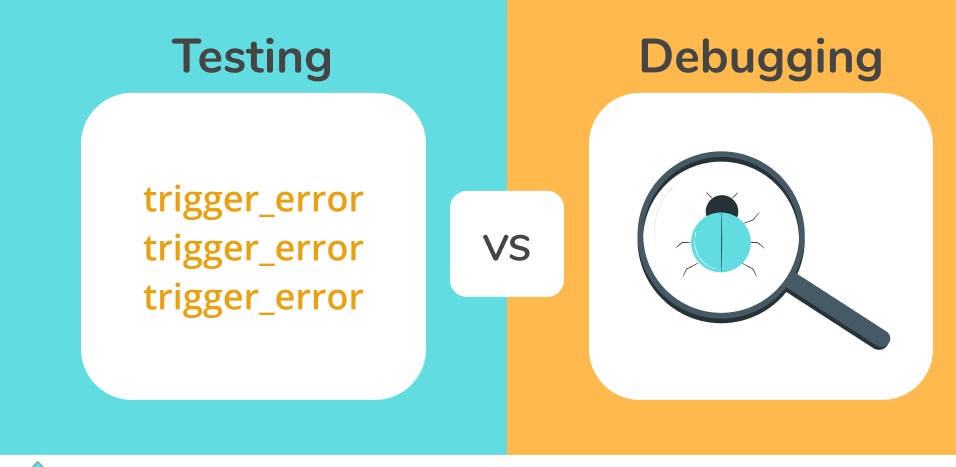Software Testing vs. Debugging: Unraveling the Difference for a Bug-Free Software
In the realm of software development, two essential processes work hand in hand to ensure the delivery of a high-quality and reliable product: software testing and debugging. While both aim to identify and address software issues, they serve distinct purposes and are executed at different stages of the development lifecycle. In this blog post, we will explore the key differences between software testing and debugging and understand how they contribute to creating bug-free software.
Understanding Software Testing: The Art of Verification
Software testing is a systematic process of evaluating a software application to determine whether it meets specified requirements and functions as expected. The primary objective of testing is to uncover defects, bugs, or discrepancies in the software’s functionality, usability, performance, and security. It helps ensure that the software behaves as intended and delivers the desired user experience.
The software testing process typically consists of the following stages
- Test Planning: Defining the testing scope, objectives, and test strategies.
- Test Design: Creating test cases and test scenarios based on functional and non-functional requirements.
- Test Execution: Running the test cases and recording the outcomes.
- Defect Reporting: Documenting and tracking the identified defects.
- Regression Testing: Re-testing previously fixed defects to ensure new changes do not introduce new issues.
Software testing is generally executed during the later stages of the development process when the software is relatively stable. It encompasses various types of testing, including unit testing, integration testing, system testing, acceptance testing, and more.
http://informationarray.com/2023/07/21/software-testing-vs-devops-striking-a-balance-for-quality-and-speed/
The Essence of Debugging: The Quest for Issue Resolution
Debugging, on the other hand, is the process of identifying, analyzing, and resolving software defects or bugs that occur during the development or testing phases. It involves tracking down the root cause of unexpected behavior, crashes, or errors within the codebase. Unlike testing, which aims to verify software functionality, debugging seeks to diagnose and rectify issues to make the software function correctly.
Key steps involved in the debugging process are as follows
- Bug Identification: Reproducing and understanding the issue based on the information available.
- Code Inspection: Reviewing the relevant code sections to identify potential sources of the bug.
- Issue Isolation: Narrowing down the root cause by examining the variables, data flow, and code logic.
- Code Modification: Fixing the bug by making necessary changes to the code.
- Verification: Testing the fixed code to ensure the bug is resolved without introducing new issues.
Debugging is an iterative process that may occur throughout the software development lifecycle. Developers and testers are primarily responsible for debugging, and their expertise plays a vital role in finding and resolving complex issues.
Collaboration and Synergy: Testing and Debugging in Harmony
While software testing and debugging serve distinct purposes, they complement each other to achieve the common goal of delivering a bug-free software product. An effective collaboration between testers and developers is crucial for the success of both processes.
- Early Detection through Testing: Robust testing practices, such as unit testing and continuous integration, can help catch issues early in the development cycle, reducing the need for extensive debugging later on.
- Informing Debugging through Testing: Testers can provide valuable information about the failing test cases to aid developers in understanding the nature and context of the bug.
- Regression Testing and Bug Verification: After debugging, regression testing ensures that the issue is genuinely resolved and that no new defects were introduced during the debugging process.
- Feedback and Continuous Improvement: Communication and feedback loops between testers and developers foster a culture of continuous improvement, enhancing the overall software quality.
In conclusion, software testing and debugging are two indispensable processes in the software development journey. Software testing verifies the functionality of the application, ensuring it meets the required standards, while debugging pinpoints and resolves issues within the code. Their collaboration and synergy play a crucial role in delivering a high-quality, bug-free software product to end-users.
By embracing rigorous testing practices and fostering effective communication and collaboration between testers and developers, software development teams can ensure that their products are resilient, reliable, and ready to meet the ever-evolving needs of users. Ultimately, the successful integration of testing and debugging processes paves the way for efficient and effective software development and enhances the overall user experience.









